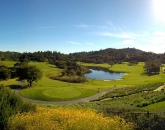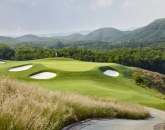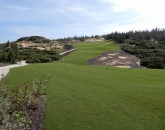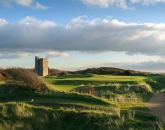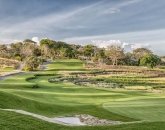When I think of excessiveness I also think about how excessively fast and how excessively over-contoured many modern green complexes are. Even I have to stick my hand up here as I have been guilty of building a few greens that could be deemed too steep. Surely, if we are to improve pace of play we should be looking to create greens that have a good amount of balance. After all, balance is the key in everything we do. Add to that we should be striving for good quality greens (smooth and consistent) because this will almost certainly equate to less putts which, ergo, equates to less time spent on them.
When I arrived at St Andrews the day before the event I wandered around the New Course – which is not so new – and noted how many golfers hit the ball along the ground unintentionally ... although this is no bad thing in blustery conditions. I suspect it’s these very golfers that would find our modern layouts too difficult to play given how many of these courses demand the ball to be played in the air, particularly when approaching the green. It was the legendary architect Alister MacKenzie who said that “a great golf hole is one you can play with your putter”, meaning you can attack the course on the ground as much as in the air My feeling is that If we are to improve the golf experience and pace of play we need to give golfers a multitude of play options – let’s give them the opportunity to play the shot with the club they feel most comfortable with.
Lastly, when I think of excessiveness I think of the visual clutter that litters many of our modern golf courses. The result being that golfers today find themselves “ping-ponging” from one feature to the next, and all in the space of just one hole. It is disheartening to watch. Certainly most of the golf facilities I visit today would be better if they did away with more and I believe this would have a positive effect on the time it takes to play a round of golf.
Most of the golf courses being built or even rebuilt nowadays are visually spectacular. No other feature is used more often to “beautify” a golf course than that of the sand bunker. In fact it has got to the point where most of our modern golf courses are defined by sand, and that includes the playing strategy. It seems to me that the bunker is the golf architects 'go-to' feature.
I wrote about this subject within these pages 18 months ago [see By Design – May 2014 issue]: “The mad desire to have men and women groping around eighteen holes in sand, straining their glazed and agonizing eyes for a bit of fairway”. Don’t get me wrong, I believe bunkers are an integral part of the game but for the everyday golfer they are hard to negotiate and certainly take time to play out of. Perhaps, as a start, and as noted by Alister MacKenzie, we need "fewer bunkers placed in more interesting positions."
Readers will know that I’m an advocate for ground contouring and this is obvious in the courses I have worked on. During my speech I emphasised the need to use more ground contouring (as a design feature) to help with pace of play and to make the game more fun and interesting. You see ground contours – humps and bumps, depressions and mounds – are not hard to negotiate (certainly not as hard as bunkers). Mow them as tight as the fairway and the shot options and possibilities are multiplied considerably. Remember: give the golfer the opportunity to play the shot (with the club) they are most comfortable with and I bet the outcome is much improved all round.
Rough is a major headache but it need not be. My thinking – and indeed I put this to practice – is that when it comes to far rough areas, it’s all or nothing. By "all" I mean make the far rough areas so dense that it’s impenetrable to the point where no one’s going looking for their ball. Certainly in Asia I don’t want golfers searching for their golf ball in rough areas where it’s hard to see what’s beneath their feet. In this case, use native vegetation which will help make the golf course much more identifiable (or give it a better sense of place).
By “nothing” I mean use a material type that will make it very easy to locate your ball and anything else. This could be wood-chip, pine needle, sand (if on a sandbase) or indeed if it’s grass, ensure the cut is consistent all round and that you can see the equator of the golf ball.
In my opinion the key to everything is great variety and balance and this also extends to other features that could potentially affect pace of play – like water and blind shots. I suppose water has less effect on pace of play – because you are not going searching for you ball. Although too much water is likely to have a negative effect as golfers find themselves getting very wet and indeed frustrated at the same time. At the end let’s get variety in everything we do and lets strike a happy medium. This way I am certain we will go a long way in improving the golf experience. And that includes the pace of play.
Pages
Click here to see the published article.


